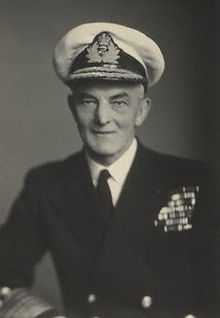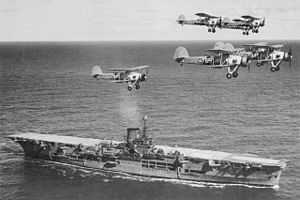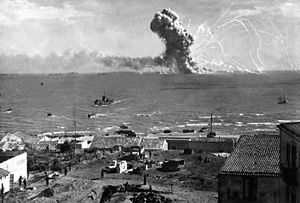Arthur Power
| Sir Arthur John Power | |
|---|---|
 Sir Arthur Power | |
| Born |
12 April 1889 London, England |
| Died |
28 January 1960 (aged 70) Royal Naval Hospital, Haslar |
| Allegiance |
|
| Service/branch |
|
| Years of service | 1904–1953 |
| Rank | Admiral of the Fleet |
| Commands held |
Gunnery School, Portsmouth HMS Excellent (3 Oct 1935 - Jul 1937) HMS Ark Royal 17 Jan 1938 - 26 Jul 1938 15th Cruiser Squadron (1 Aug 1942 - May 1943) Flag Officer, Malta (7 May 1943 - Aug 1943) 1st Battle Squadron & Second-in-Command, Eastern Fleet (1 Dec 1943 - Jun 1944) East Indies Fleet (22 Nov 1944 - Jul 1945) Chief of Naval Personnel (Second Sea Lord) (27 Feb 1946 - 1948) Mediterranean Fleet (13 May 1948 - May 1950) Commander-in-Chief, Portsmouth (18 Oct 1950 – 17 Oct 1952) Allied Commander in Chief, Channel and Southern North Sea Command (1952) |
| Battles/wars |
World War I World War II |
| Awards |
Knight Grand Cross of the Order of the Bath Knight Grand Cross of the Order of the British Empire Commander of the Royal Victorian Order Mentioned in Despatches 4 times Legion of Merit Order of Orange-Nassau Knight of the Order of the Hospital of St John of Jerusalem |
| Other work |
First and Principal Naval Aide-de-camp to King George VI (15 Jan 1951 – 24 Apr 1952) & to Queen Elizabeth (Jan - Apr 1952) Deputy Lieutenant, Southampton (27 Apr 1953) |
Admiral of the Fleet Sir Arthur John Power GCB, GBE, CVO (12 April 1889 – 28 January 1960) was a Royal Navy officer. He took part in First World War as a gunnery officer and saw action in the Dardanelles Campaign. During the inter-war years he commanded the gunnery school HMS Excellent and then the aircraft carrier HMS Ark Royal. During the Second World War he played a leading role in the planning for the Allied invasion of Sicily and for the Allied invasion of Italy and then commanded the naval forces for the actual landing of V Corps at Taranto in Italy in September 1943. He went on to be Commander-in-Chief of the East Indies Fleet in the closing stages of the War and conducted naval strikes on the Imperial Japanese Army in Borneo and Malaya. After the War he became Second Sea Lord and Chief of Naval Personnel, Commander-in-Chief, Mediterranean Fleet and then Commander-in-Chief, Portsmouth.
Naval career
Early career
Born the son of Edward John Power and Harriet Maud Power (née Windeler),[1] Power joined the training ship HMS Britannia as a cadet in 1904 and, having won the King's medal as best cadet of his year, he was promoted to midshipman on 15 September 1905.[2] He was promoted to acting sub-lieutenant on 15 January 1909[3] and to lieutenant on 15 April 1910[4] on his appointment to the battlecruiser HMS Indomitable in the Home Fleet.[2] He became First Lieutenant in the destroyer HMS Nautilus in October 1912 and then attended HMS Excellent, the gunnery school at Portsmouth, in 1913.[5]
Power served as a gunnery officer throughout First World War, initially in the battleship HMS Magnificent, then in the cruiser HMS Royal Arthur and next in the monitor HMS Raglan.[5] In the Raglan he saw action in the Dardanelles Campaign, before transferring to the battlecruiser HMS Princess Royal in the Grand Fleet.[5] He was promoted to lieutenant commander on 15 April 1918.[6]
After the War Power joined the directing staff at HMS Excellent.[5] Promoted to commander on 31 December 1922,[7] he became Assistant Director in the Naval Ordnance Department at the Admiralty in January 1923 and, after attending the Royal Naval Staff College, he became Executive Officer on HMS Hood, flagship of the battlecruiser squadron in the Atlantic Fleet in 1925.[5] He joined the directing staff at the Royal Naval Staff College in 1927 and, having been promoted to captain on 30 July 1929,[8] he joined the Ordnance Committee at the Royal Arsenal.[5] He became Flag Captain of the Second Cruiser Squadron in the Home Fleet in the cruiser HMS Dorsetshire in April 1931 and, having served on the directing staff at the Imperial Defence College in 1933, he became commanding officer of the gunnery school HMS Excellent in October 1935.[5] He was appointed a Commander of the Royal Victorian Order on 29 January 1936.[9] He went on to be commanding officer of the aircraft carrier HMS Ark Royal in September 1937, and in that capacity, also became Flag Captain to the Flag Officer commanding aircraft carriers in the Home Fleet in July 1939.[5]
The Second World War


Power served in the Second World War as Assistant Chief of the Naval Staff from May 1940 and was granted promotion to rear admiral on 25 June 1940.[5] Appointed a Companion of the Order of the Bath on 1 July 1941,[10] he became commander of the 15th Cruiser Squadron in the Mediterranean Fleet with his flag in the cruiser HMS Cleopatra in August 1942.[5] Appointed Flag Officer in charge of Malta in May 1943, he played a leading role in the planning for the Allied invasion of Sicily in July 1943 and, having been promoted to vice admiral on 4 August 1943,[11] he led the planning for the Allied invasion of Italy and then commanded the naval forces for the actual landing of V Corps at Taranto in Italy in September 1943.[5] Following the landings, he became head of the Allied military mission to the Italian Government and was briefly Commander of the 1st Battle Squadron and second in command of the Mediterranean Fleet.[5]
Advanced to Knight Commander of the Order of the Bath on 1 January 1944,[12] Power became commander of the 1st Battle Squadron and second in command of the Eastern Fleet with his flag in the battlecruiser HMS Renown in January 1944.[5] He went on to be Commander-in-Chief of that fleet, renamed the East Indies Fleet, in November 1944 and conducted naval strikes on the Imperial Japanese Army in Borneo and Malaya.[5] Flying his flag in HMS Cleopatra, the first British ship to enter Singapore since the fall of that city over three years earlier, Power arrived in style to attend the final surrender of the Japanese there in September 1945.[13]
Later career
Power was appointed Knight Grand Cross of the Order of the British Empire on 1 January 1946[14] and became Second Sea Lord and Chief of Naval Personnel in February 1946.[15] Promoted to full admiral on 6 May 1946,[16] he proceeded to manage the run-down in naval manpower after the War.[15] He went on to be Commander-in-Chief, Mediterranean Fleet in May 1948 and, having been advanced to Knight Grand Cross of the Order of the Bath on 2 January 1950,[17] he became Commander-in-Chief, Portsmouth in September 1950.[15] He was also appointed First and Principal Naval Aide-de-Camp to the King on 15 January 1951[18] and was double-hatted as NATO Allied Commander-in-Chief, Channel and Southern North Sea Command from 1952.[15] He attended the funeral of King George VI in February 1952[19] and was promoted to Admiral of the Fleet on 22 April 1952.[20]
Power retired in September 1952 and became a Deputy Lieutenant of Southampton on 27 April 1953[21] shortly before attending the coronation of Queen Elizabeth II in June 1953.[22] He died at the Royal Naval Hospital, Haslar on 28 January 1960.[15]
Family
In 1918 Power married Amy Bingham; they had three sons (including Vice Admiral Sir Arthur Mackenzie Power).[1] Following the death of his first wife in 1945, he married Margaret Joyce Watson in 1947.[1]
Honours and awards
- Knight Grand Cross of the Order of the Bath - 2 January 1950[17] (KCB - 1 January 1944;[12] CB - 1 July 1941[10])
- Knight Grand Cross of the Order of the British Empire - 1 January 1946[14]
- Commander of the Royal Victorian Order - 29 January 1936[9]
- Mentioned in dispatches - 21 December 1943, 23 May 1944,[23] 15 June 1944 and 31 October 1944[24])
- Polonia Restituta 3rd class (Poland) - 22 December 1942[25]
- Commander of the Legion of Merit (US) - 29 January 1946[26]
- Grand Cross of the Order of Orange Nassau (Netherlands) - 15 March 1949[27]
- Knight of the Order of the Hospital of St John of Jerusalem - 1 January 1951[28]
References
- ↑ 1.0 1.1 1.2 "Arthur Power". Oxford Dictionary of National Biography. Retrieved 25 August 2014.
- ↑ 2.0 2.1 Heathcote, p. 218
- ↑ The London Gazette: no. 28287. p. 6814. 10 September 1909. Retrieved 25 August 2014.
- ↑ The London Gazette: no. 28424. p. 7253. 14 October 1910. Retrieved 25 August 2014.
- ↑ 5.0 5.1 5.2 5.3 5.4 5.5 5.6 5.7 5.8 5.9 5.10 5.11 5.12 5.13 Heathcote, p. 219
- ↑ The London Gazette: no. 30640. p. 4742. 19 April 1918. Retrieved 25 August 2014.
- ↑ The London Gazette: (Supplement) no. 32782. p. 14. 29 December 1922. Retrieved 25 August 2014.
- ↑ The London Gazette: no. 33513. p. 4360. 2 July 1929. Retrieved 25 August 2014.
- ↑ 9.0 9.1 The London Gazette: no. 34253. p. 811. 7 February 1936. Retrieved 25 August 2014.
- ↑ 10.0 10.1 The London Gazette: (Supplement) no. 35204. p. 3735. 10 June 1948. Retrieved 25 August 2014.
- ↑ The London Gazette: no. 36133. p. 3648. 13 August 1943. Retrieved 25 August 2014.
- ↑ 12.0 12.1 The London Gazette: (Supplement) no. 36309. p. 3. 31 December 1943. Retrieved 25 August 2014.
- ↑ "The final surrender". The Independent. 20 August 1995. Retrieved 25 August 2014.
- ↑ 14.0 14.1 The London Gazette: no. 37407. p. 13. 28 December 1945. Retrieved 25 August 2014.
- ↑ 15.0 15.1 15.2 15.3 15.4 Heathcote, p. 220
- ↑ The London Gazette: (Supplement) no. 37615. p. 3078. 18 June 1946. Retrieved 25 August 2014.
- ↑ 17.0 17.1 The London Gazette: (Supplement) no. 38797. p. 2. 30 December 1949. Retrieved 25 August 2014.
- ↑ The London Gazette: no. 39175. p. 1441. 16 March 1951. Retrieved 25 August 2014.
- ↑ The London Gazette: (Supplement) no. 39575. p. 3366. 17 June 1952. Retrieved 25 August 2014.
- ↑ The London Gazette: no. 39571. p. 3238. 13 June 1952. Retrieved 25 August 2014.
- ↑ The London Gazette: no. 39841. p. 2421. 1 May 1953. Retrieved 25 August 2014.
- ↑ The London Gazette: (Supplement) no. 40020. p. 6268. 17 November 1953. Retrieved 25 August 2014.
- ↑ The London Gazette: (Supplement) no. 36526. p. 2355. 19 May 1944. Retrieved 25 August 2014.
- ↑ The London Gazette: (Supplement) no. 36771. p. 4977. 27 October 1944. Retrieved 25 August 2014.
- ↑ The London Gazette: (Supplement) no. 35833. p. 5569. 18 December 1942. Retrieved 25 August 2014.
- ↑ The London Gazette: (Supplement) no. 37448. p. 720. 25 January 1946. Retrieved 25 August 2014.
- ↑ The London Gazette: no. 38563. p. 1334. 15 March 1949. Retrieved 25 August 2014.
- ↑ The London Gazette: no. 39116. p. 136. 5 January 1951. Retrieved 25 August 2014.
Sources
- Heathcote, Tony (2002). The British Admirals of the Fleet 1734 – 1995. Pen & Sword Ltd. ISBN 0-85052-835-6.
| Military offices | ||
|---|---|---|
| Preceded by Sir Stuart Bonham Carter |
Flag Officer, Malta May 1943–October 1943 |
Succeeded by Sir Louis Hamilton |
| Preceded by Sir Bruce Fraser |
Commander-in-Chief, East Indies Station 1944–1945 |
Succeeded by Sir Clement Moody |
| Preceded by Sir Algernon Willis |
Second Sea Lord 1946–1948 |
Succeeded by Sir Cecil Harcourt |
| Preceded by Sir Algernon Willis |
Commander-in-Chief, Mediterranean Fleet 1948–1950 |
Succeeded by Sir John Edelsten |
| Preceded by Sir Algernon Willis |
Commander-in-Chief, Portsmouth 1950–1952 |
Succeeded by Sir John Edelsten |
| Honorary titles | ||
| Preceded by Sir Henry Moore |
First and Principal Naval Aide-de-Camp 1949–1952 |
Succeeded by Sir Rhoderick McGrigor |